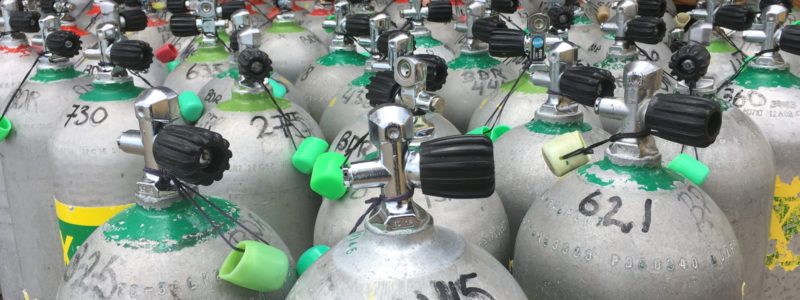What the heck? Partial Pressure Explained …
Partial pressure is a term used in gas laws. Without getting into a physics lesson, in a gas mixture, each gas has a partial pressure which is equal to the fraction of gas represented in the mix multiplied by the pressure.
Continued from: Part 2 Oxygen Toxicity and the New Diver
Thus, in the examples above, air has a 21% fraction of oxygen. At sea level, or one atmosphere (as the air pressure is measured), it has a partial pressure of 0.21. Sometimes you will see this written as PPO2 = 0.21. In salt water, every 33 feet is equivalent to the weight of an additional 1 atmosphere (34 feet for fresh water and you have to add 1 atmosphere for the air on top of the water). So at 33 feet, you have the equivalent weight of 2 atmospheres of pressure, 66 feet, is the equivalent of 3 atmospheres, 99 feet is the equivalent of 4 atmospheres, and 132 feet is the equivalent of 5 atmospheres. Thus, in our example above, using air, at 33 feet, you would multiply the fractional gas of 21% times 2 atmospheres which would equal 0.42 (or 42%). That means, air is twice as effective at 2 atmospheres or 2 ATA (atmospheres absolute).
Using the 40% mix example above: Taking 40% to 3 ATA or 66 feet is equivalent to having 120% oxygen or a partial pressure of 1.2. Another example is taking the most common blend of enriched air available, 32% Nitrox, and taking that to depth. At 33 feet, enriched air with 32% (usually written EAN32) has a partial pressure 0.64. Taking EAN32 to 4 ATA or 99 feet, means that it has a partial pressure of 1.28. Or if you take that same 32% blend to 5 atmospheres or 132 feet, you will have a partial pressure of 1.6, which is equivalent to 160% oxygen. As mentioned previously, you risk the chance of CNS oxygen toxicity when it reaches that level.
Optimal Partial Pressures While Scuba Diving
When scuba diving, you always want to keep your oxygen partial pressures between 0.16 (16%) and 1.6 (160%). If you fall below or go above this range you risk serious injury and death. Even on air, foolish people can exceed a partial pressure of 1.6. That is why we recommend an additional safety margin and tell our divers not to exceed a partial pressure blend of 1.4. If you are planning a dive that will result in a 1.5 or 1.6 partial pressure mix, drop the O2 mix down a percentage point or two. As always, plan your dive (conservatively and within your limits) and dive your plan.
Because we are constantly dealing with pressure underwater, it is very possible that you could exceed a 1.6 partial pressure. However, it is very difficult to go below 0.16. While not exclusively, this usually occurs only in Trimix diving. Oxygen management in Trimix diving is a more complex discussion, although the fundamentals you learn in Nitrox diving remain the same.
Bottom line, don’t exceed a 1.4 partial pressure and stay safe!
Is that a freight train or barking dogs I hear?
As mentioned, the effect of hyperoxia while diving is generally a convulsion. And while this can come on without warning, it has been reported that several precursors may reveal themselves prior to the convulsion. If you experience one of these precursors, you should end your dive immediately. Unlike nitrogen narcosis, going up a few feet will not dispel the oncoming convulsion. You are toxic! These precursor events to a Tox Hit include visual disturbances (like tunnel vision), ear ringing or strange sounds like a barking dog, nausea, muscle twitching (usually in the face), irritability, and dizziness. Note: a convulsion does not necessarily have to have a precursor symptom.
If at any time you do not feel 100% fine, regardless of your partial pressure, you should surface – safely – without hesitation. No dive is worth being your last.
# 1 Rule in Enriched Air Diving and Oxygen Management
Obviously, the key to oxygen management is partial pressure awareness. Knowing your depth and knowing your gas blend are the critical components to partial pressure awareness. There is only one way to truly “know” your gas blend and that is to analyze it. If you are a Nitrox diver, you should have an analyzer, be trained to use it, and do so. Don’t trust anyone on telling you what is the blend. Analyze it yourself. Thus, the number 1 rule in enriched air diving is to always (and I mean always) analyze your own mix. Once you have that, you can calculate your partial pressures and know exactly what depth equals a 1.4 partial pressure with your blend. And, of course, you know your maximum operating depth at 1.6. Once you have done this, using masking or duct tape, write your name, mix, and maximum operating depth on the tape and stick it on your tank.
Final and Most Important Thoughts
To truly understand enriched air or Nitrox diving, you need training! This article is only a quick overview on oxygen management and a quick introduction to enriched air diving. Do not attempt, in any way, to use this article or any of the construed advice as training. Do not dive enriched air unless you are certified and qualified to do so. That means a certified enriched air scuba instructor has signed off that you are trained to dive enriched air. Scuba diving is a great sport, but dangerous if you do not dive within your training limits.


